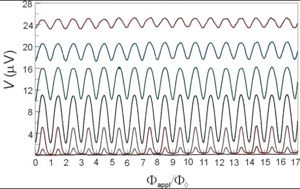Ph.D. thesis
Thesis title: | MgB2 thin films and Josephson devices |
Year: | 2004 |
Promotors: | Prof. Dr. H. Rogalla and Prof. Dr. Ing. D.H.A. Blank |
Assistant promotor: | Dr. Ing. A.J.H.M. Rijnders and Dr.Ir. J.W.M. Hillgenkamp |
Summary
The discovery of superconductivity with a critical temperature (TC) of 39 K in magnesium diboride (MgB2) compound, announced in January 2001, has triggered an intensive worldwide research on this compound, first synthesized in the 1950’s. The remarkable properties of MgB2 open a new window in superconductivity for fundamental as well as applied research. MgB2 is a very simple binary compound, but with surprising properties. It was found to be an electron-phonon superconductor with a much higher critical temperature and a significantly smaller isotope shift than Bardeen-Cooper-Schrieffer (BCS) theory would predict. Furthermore, whereas the concept of two superconducting gaps present in a superconductor has been considered before, MgB2 is the first example where this effect is strongly expressed.
The critical temperature of MgB2 of 39 K enables the realization of electronic circuits based on this material to operate at 20-25 K, achievable by a compact cryocooler, which gives a significant advantage to this material compared to the low-temperature superconductors. Compared to the high-temperature superconductors MgB2 is simpler, cheaper and more stable over time. The nature of the superconductivity in MgB2 and the advantageous properties of this material are briefly discussed in the thesis.
To realize superconducting Josephson devices based on this material that can be implemented further in electronic circuits, epitaxially grown MgB2 thin films are desired. Ideally, the crystalline MgB2 thin films are desired for Josephson junction fabrication to ensure the tunneling in the a-b plane where the higher superconducting gap is present.
In the thesis the main features of the deposition techniques used in thin film fabrication and analysis tools needed for thin film structure and morphology investigation. The high vapor pressure of magnesium and the high affinity of magnesium and boron to oxidation are necessary to overcome during fabrication of MgB2 thin films. To find the optimum conditions and parameters for MgB2 deposition in vacuum techniques, several aspects of MgB2 thin film growth were analyzed and discussed.
Two methods used for the preparation of MgB2 thin films are discussed: Pulsed Laser Deposition (PLD) and by Hybrid Physical-Chemical Vapor Deposition (HPCVD).
Furthermore, the fabrication of weak links made in MgB2 films is described and analyzed. The films prepared by pulsed-laser deposition were used for the first realization of all-MgB2 ramp-type Josephson junction. In films made by HPCVD nanobridges were structured as another approach the formation of weak links. The thesis gives an insight into the properties of the weak links as well as outlooks for improvement of the Josephson junctions.
|
Scanning Electron Microscope image of an MgB2 nanobridge (70x150 nm) |
MgB2 ring-structures incorporating nanobridges display Josephson quantum interference effects, which forms the basis for the creation of all-MgB2.
Superconducting Quantum Interference Devices (SQUIDs). The experimental realization of nanobridge-based MgB2 SQUIDs made from both, PLD and HPCVD films, and their properties are also presented in the thesis of Dragana Mijatovic.
|
SQUID voltage modulation by applied magnetic field at 37 K for the SQUID with 140 nm wide nanobridges, at different values of the current bias. Voltage modulation shows maximum value of 8 μV. |
Dragana did her PhD in the Low Temperature Division and MASIF, the strategic orientation of MESA+. Her supervisors were prof. dr. Horst Rogalla and prof. dr. ing. Dave H.A. Blank. The co-supervisors were dr. ir. Hans Hilgenkamp and dr. ing. Guus Rijnders.


